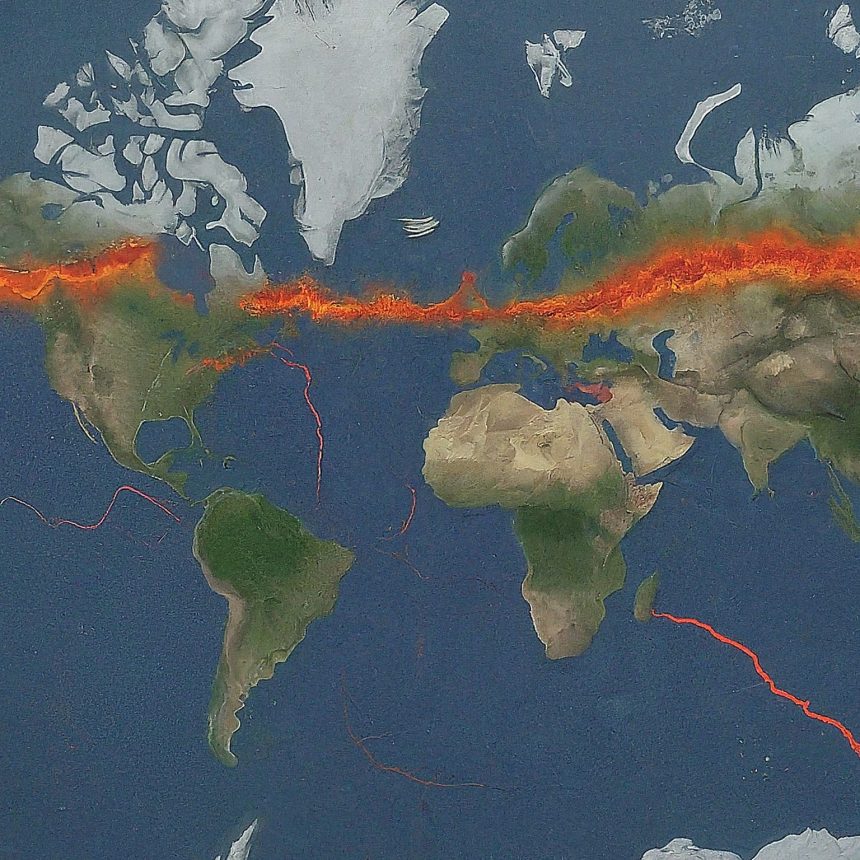The Pacific Ocean’s Ring of Fire, a seismic belt renowned for its intense earthquake activity and volcanic eruptions, encircles the Pacific Ocean in a horseshoe shape, home to approximately three-quarters of the world’s volcanoes. Yet, a relatively obscured chapter in Earth’s tectonic narrative draws attention to a dormant subduction zone beneath the Atlantic Ocean. This slumbering behemoth, if reactivated, carries the potential to dramatically transform the planet’s geographical fabric.
Beneath the Atlantic: A Dormant Behemoth
Hidden beneath the Atlantic’s vast waters rests a quiet subduction zone, a geological fault where two tectonic plates converge, one sliding beneath the other. This process is responsible for some of the planet’s most dramatic geological events, including the creation of mountain ranges, volcanic activity, and earthquakes. Despite the Atlantic’s current geological tranquility, the presence of this inactive subduction zone introduces an element of unpredictability into forecasts of Earth’s tectonic future.
The Stirring of a Giant
The hypothetical awakening of this Atlantic subduction zone, prompted by tectonic shifts, heralds a scenario of profound consequences. Such an event could see swathes of the Atlantic Ocean being consumed by subduction, radically altering coastlines, birthing new volcanic activity, and potentially giving rise to fresh mountain chains as the oceanic crust succumbs to the continental crust’s might.
The Ripple Effects of Tectonic Awakening
Should this Atlantic subduction zone awaken, it would precipitate significant environmental and human impacts. Areas in close proximity would face a surge in seismic activity, including potentially catastrophic earthquakes and volcanic eruptions. Over the eons, the transformation could extend to the Atlantic’s physical geography and the adjoining continents, affecting climate patterns, oceanic currents, and the web of life itself.
Echoes from the Past
While this narrative might mirror science fiction, Earth’s geological history is replete with such transformative events. The Himalayas’ majestic rise is a testament to the subduction of the Indian Plate beneath the Eurasian Plate, a slow yet relentless process spanning millions of years. This historical context suggests that any modifications to the Atlantic would unfold over geological timescales, far beyond the human temporal frame.
Vigilance and Exploration
In light of the potential repercussions, vigilant monitoring of the Atlantic’s subduction zone is imperative. Modern advancements in seismology and oceanography enable scientists to meticulously track tectonic plate movements, offering forecasts of potential geological activities. Ongoing exploration is vital for deciphering Earth’s crustal dynamics and preparing for future geological phenomena, however distant they may seem.
Epilogue: On the Cusp of Discovery
The Ring of Fire’s ability to alter the Atlantic underscores our planet’s dynamic essence, revealing the constant flux underlying its surface. Although the concept of the Atlantic Ocean’s subduction zone reawakening remains speculative, it accentuates the critical role of geological exploration and vigilance. As we delve further into the enigmas of terrestrial geology, we are reminded of the formidable natural forces that have sculpted the Earth’s surface and will continue to shape its destiny.








